The recently published book, "A Study on the Missionary History of Religious Orders and Congregations in China," investigates the Catholic missionary work carried out in China from the early 20th century to the 1950s, focusing on various Catholic religious orders.
In April, China Religious Culture Publisher released the book co-authored by Professor Liu Zhiqing and Professor Shang Haili.
Religious orders and congregations are essential components of the Catholic Church, comprising both male and female orders that operate globally or within specific dioceses. International orders require approval from the Pope for their establishment, while diocesan orders are approved by the local bishops. Each religious order typically has its own set of rules and regulations.
Orders such as the Franciscans and Dominicans in the 13th century, emphasis on the principle of poverty and the renunciation of personal possessions (although they gradually acquired some property over time). Members of these orders adopted an itinerant lifestyle, venturing outside the confines of the monastery to beg for alms. As a result, they came to be known as the "mendicant orders."
Following the Religious Reformation in the 16th century, new orders like the Jesuits emerged, engaging in charitable work and operating without the constraints of a stable monastery, nor did they adhere to a standardized uniform, which led to their designation as the "new religious orders."
During the era of Western colonialism, missionary orders arose to send missionaries to various regions, including Asia, Africa, and Latin America. In China, 27 male religious orders arrived in the late Ming and early Qing Dynasties to preach and establish dioceses, forming the main focus of the book's research.
The extensive 560,000-word book provides an in-depth exploration of the history of Chinese Catholic dioceses within the framework of religious orders. It examines the missionary work and diocesan management carried out by the 27 male religious orders in contemporary China, offering detailed insights into specific dioceses. The book not only chronicles the history and achievements of these religious orders in China but also presents statistical summaries of their work and dioceses. It addresses both the overall missions of foreign religious orders in China and the historical details of each specific missionary order. Special attention is given to the relationships between religious orders and their affiliated dioceses, interconnections among different orders, the development of parishes and churches under the purview of religious orders, and the fluctuations in the number and turnover of missionaries. By painting a comprehensive picture of how missionary orders operated in China, the book analyzes their impact on Chinese churches and traces the historical trajectory of the Sinicization of Catholicism.
- Translated by Joyce Leung












